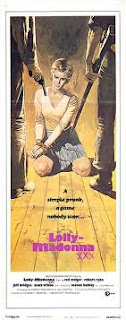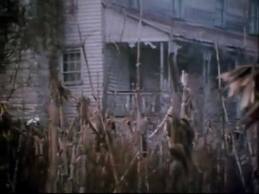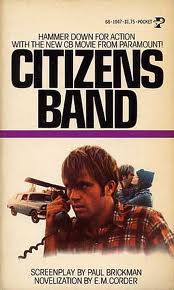
In the early 70's, I used to listen to Giants' baseball on KSFO in San Francisco well into the evening. After the game wrapped, the station would play old time radio shows like Suspense, Lights Out and Escape. There was nothing better for an eleven year old kid than listening to a ball game capped off with some late night horror. One evening, the station played an episode of Escape which was a two part adaptation of
George R Stewart's post apocalyptic novel Earth Abides.
 The main character and narrator of the adaptation was voiced by legendary character actor John Dehner. Dehner's bass baritone was perfect for describing the post apocalyptic landscape of San Francisco, whether it was being besieged by an over abundance of rats or being threatened by a massive fire. Hearing only Dehner's voice, and a few sound effects, my imagination was sparked to such an extent that I could easily think the city that I lived less than an hour away from was completely deserted. I was absolutely mesmerized by the production and the thought of empty cities around the world gave me the chills.
The main character and narrator of the adaptation was voiced by legendary character actor John Dehner. Dehner's bass baritone was perfect for describing the post apocalyptic landscape of San Francisco, whether it was being besieged by an over abundance of rats or being threatened by a massive fire. Hearing only Dehner's voice, and a few sound effects, my imagination was sparked to such an extent that I could easily think the city that I lived less than an hour away from was completely deserted. I was absolutely mesmerized by the production and the thought of empty cities around the world gave me the chills.
The next day I immediately tracked down Stewart's novel at the local library. The book was naturally a lot more complex with much deeper themes than could be managed in an hour of radio drama. It was partly a hypothetical environmental impact story and partly a treatise on life's meaning and the human condition all wrapped up in one man's tale of survival and his attempt at reconstituting society. If JP Sartre had been an environmentalist, he would have written something like Earth Abides.
Hearing the radio show, reading the book and also seeing The Omega Man and Panic in the Year Zero in the same year, I became a die-hard post apocalyptic fan. There was something fascinating about a world devoid of people. How would they survive and reconstruct the world, and what form would it take, were all questions that fascinated me to no end. But I think the old radio show was the most effective at creating the P/A world, and best of all, it used my own imagination to fuel the story. That's something the P/A genre should excel at, but doesn't always succeed in doing. Part of the problem, in my opinion, is that what was once my favorite genre hands down, has fractured into several sub-genres which have other agendas or problems associated with being imaginative or thematically relevant:
a) Mullets and Mohawks - Silly, fun and endlessly entertaining, but that's about all as this type of P/A is almost entirely action based. Any strong themes or imaginative aspects tend to get in the way of the essential action beats of these films. It's why Beyond Thunderdome was a train wreck.
b) Zombie Apocalypse - Romero was about the only director who tried to inject a little theme and imagination into this genre, the rest were mostly just exploitation gore-fests. Zombies aren't interesting, the end of the world is, which is why Dawn of the Dead may never be eclipsed in this genre.
c) Nuclear Annihilation - Easily the second strongest P/A sub-genre. It's thematically limited though to basically one 'don't push The Button' message, but these cautionary films tend to be powerful and very imaginative. The biggest problem of this sub-genre is that with the end of the Cold War, the threat of total nuclear annihilation seems to be fading. Try watching Testament, Threads or The Day After - though quite good, they all seem very dated and part of history now.
d) Pandemic or Natural Disaster - This sub-genre has ample room for themes whether anthropological, social, environmental of most anything else. It's easier to focus on the big philosophical questions when there's no distractions like zombies or leather clad bikers running around. There are also endless ways to re-imagine the world and how it will evolve if it hasn't been nuked. The imaginative possibilities are what makes the pandemic scenario the most interesting to me and what drew me to Ever Since the World Ended.
Synopsis: San Francisco, 12 years after the apocalypse
The film is a clever, low budget, faux documentary that is set in and around San Francisco twelve years after a plague has wiped out all but 186 people in the city. Directed by Calum Grant and Joshua Atesh Litle, the film consists primarily of interviews and interaction with the some of the city's inhabitants, along with shots of empty streets, hillsides and beaches. The film is partly powered by the viewer's imagination which may work for some and be problematic for others. There are no cannibals, evil cults, zombies or anything else to distract from the rather ordinary survivors and their stories and thoughts on what has occurred.

As the lives and philosophies of the survivors are explored, there are three or four story lines also interwoven into the documentary. One of the most interesting involves "Mad Mark", a former emergency service worker who was exiled from the city for arson but has recently returned. This reminded me of a very similar plot complication in Earth Abides, where the fledgling community had to deal with an undesirable who wasn't yet guilty of a crime, but no doubt would be. How the small groups in both stories dealt with this issue was very telling.
Another aspect of the film that's interesting is the dichotomy of attitudes between the older generation, who have clear memories of pre-apocalyptic times, and the kids, who are teenaged or younger, and have no memory of what life was like before the pandemic. The kids POV is mainly voiced by the character of James, played flawlessly by James Curry, who is both pragmatic about the new world and almost annoyed with the adults' love/hate nostalgic relationship with the old world. Although still very young with his teenage attitude on full display, James character is actually quite mature and is better equipped emotionally to deal with the post-apocalyptic world.

On the negative side, there are minor details that are a distraction to the picture being painted. The primary one is the presence of too much wardrobe and make-up for the post-apocalypse. I didn't expect everyone to walk around in sheep skins and leather chaps, but many of the characters looked like they just left the beauty salon. One teenage survivor had a purple streak in her hair and was wearing facial piercings. Really? That fashion statement is going to survive the apocalypse? A lot of the male characters have beards going, but are still a little too well groomed to be completely believable. I doubt grooming and fashion will be among the priorities in the new world. The acting, does have a few rough spots, but is pretty natural, un-melodramatic and sells the concept for the most part. My main complaint, which is actually a complement, is that I wanted to see more of the characters. There were some characters that were left behind too quickly, and never revisited. The films run time was around 75 minutes, but seemed to zip by even quicker, so there should have been time for some additional content and character development.
In summary, if you can buy into the establishing imagery and acting performances, Ever Since the World Ended is a modest, intelligent, slice of theater-of-the-mind.
Score
7/10
Very Cool - The Escape two-part episode is available for free on the interwebs! -
Earth Abides part 1
Not So Much - Despite praise at the LA film festival in April 2001, the film wasn't released until 2006.
WTF - Seriously, purple hair?


































